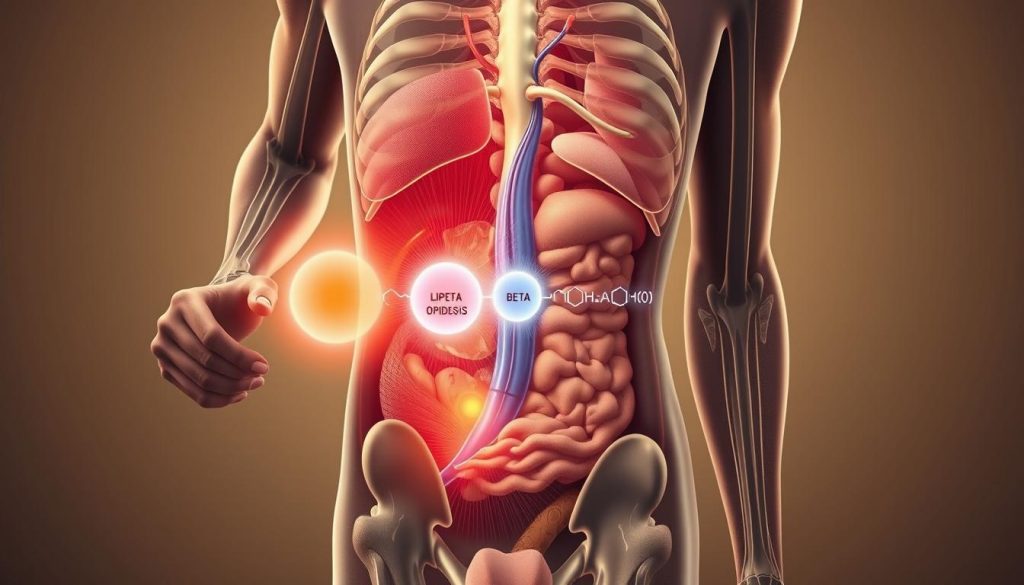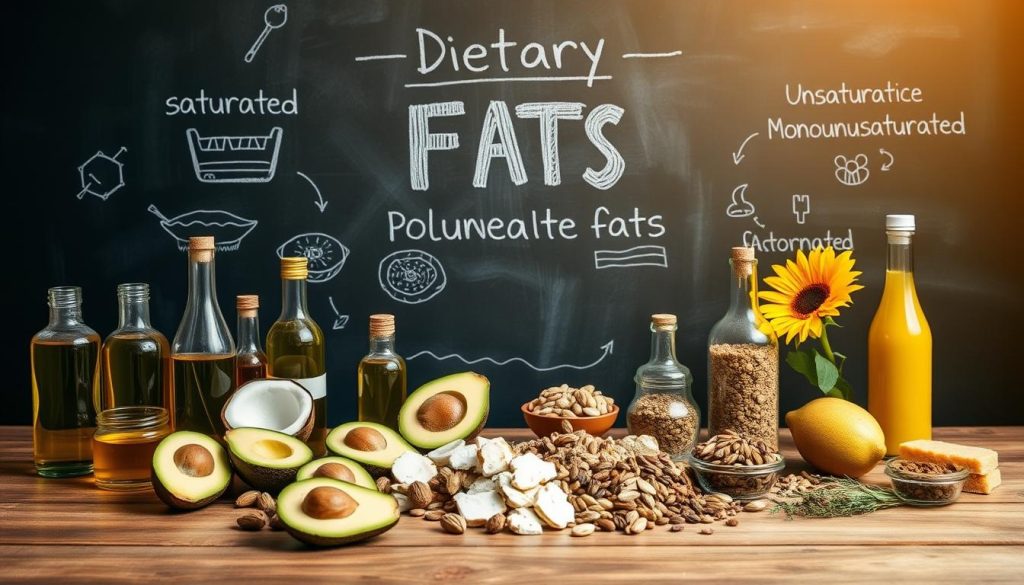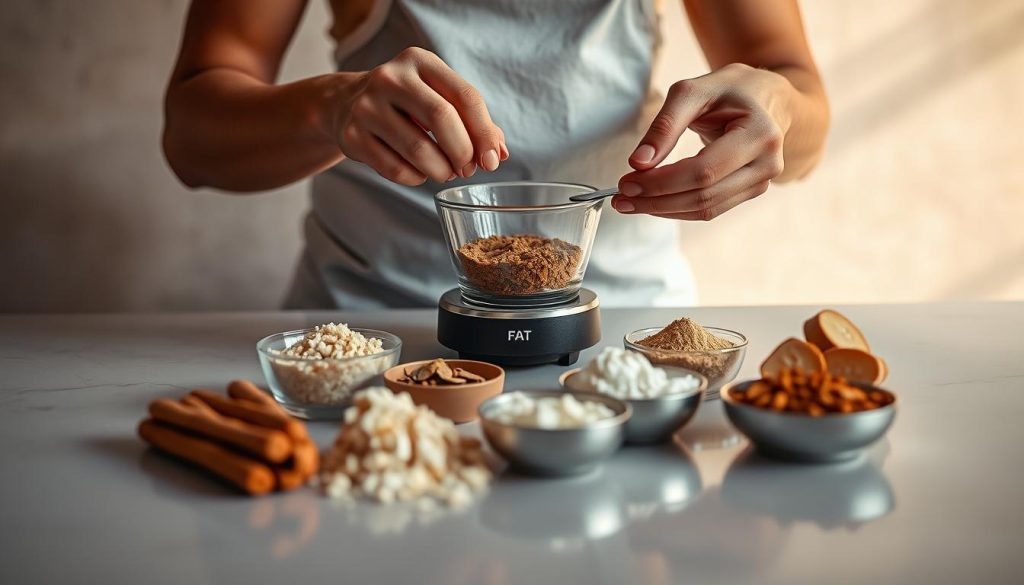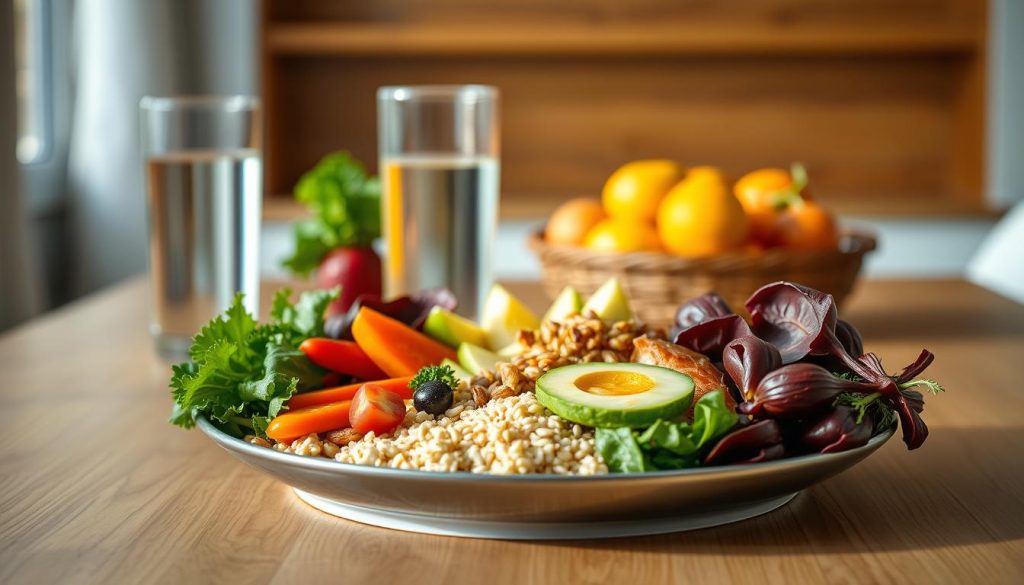Thinking about my fitness journey, I learned a big lesson. I used to think fats were just for energy. But now, I see they do so much more. They play a vital role in various bodily functions and are essential for overall health. Fats are not merely a source of calories; they are crucial for the absorption of essential nutrients and for maintaining cellular integrity. In the context of fat intake and fitness, understanding how different types of fats impact our bodies can help us optimize our diets for better performance and recovery.
Healthy fats are key for our cells and a balanced diet. Experts say they help us stay healthy and fit. Incorporating sources of healthy fats, such as avocados, nuts, and olive oil, can significantly enhance our nutritional intake. These fats provide energy and support brain function and hormone production, vital for fitness and well-being.
Choosing the proper fat intake is essential for fitness. It’s about picking foods that make us healthy. Understanding the difference between saturated and unsaturated fats can guide us in making better dietary choices. Opting for unsaturated fats can improve heart health and lower cholesterol levels, improving overall fitness and vitality.
Understanding the Role of Fat in Your Body

Fats are essential for our bodies. They help us make energy and control hormones. It’s not just about eating fats. It’s about how they help us stay healthy and fit. Dietary fats play a crucial role in our overall health by providing essential fatty acids that our bodies cannot produce independently. These fatty acids are vital for maintaining cell membranes and supporting cellular function. Additionally, healthy fats can enhance our mood and cognitive abilities, emphasizing their importance in a balanced diet.
Essential Functions of Dietary Fat
Dietary fat is key for many body functions. It helps us absorb vitamins A, D, and E, essential for various bodily processes such as vision, bone health, and immune function. These vitamins are essential for our health and maintain overall well-being.
Fats also help make hormones, chemical messengers that control how we grow, develop, and work. Hormones like estrogen and testosterone, vital for reproductive health, rely on dietary fats for their synthesis and regulation.
Some crucial jobs of dietary fat include:
- Providing energy: Fats give us a lot of energy, about 9 kcal per gram, making them a dense source of fuel for our bodies, especially during prolonged physical activities.
- Supporting cell growth: Fats are needed for cell structure and function, as they are integral components of cell membranes, ensuring cells maintain their integrity and functionality.
- Aiding in the absorption of fat-soluble vitamins, which require dietary fat for proper utilization and effectiveness in the body.
- Helping regulate body temperature is crucial for maintaining homeostasis and overall health.
How Your Body Uses Fat for Energy
When we eat fats, they turn into fatty acids and glycerol. Our body uses these for energy. This process involves the digestion, absorption, and oxidation of fatty acids. During digestion, enzymes break down fats into these smaller components, which are absorbed through the intestinal walls into the bloodstream. Once in the bloodstream, fatty acids can be transported to various tissues, where they undergo oxidation to produce ATP, the energy currency of our cells. This complex process ensures that our bodies can efficiently convert dietary fats into usable energy.
Fats are key for long, slow activities. They are a primary fuel source during these times. The body relies heavily on fat stores in endurance sports after depleting glycogen reserves. This is why training at lower intensities can help enhance the body’s ability to utilize fat as a primary energy source, improving overall endurance and performance.
We need to know a few things to use fat well for energy. Our body uses both fat and carbs for fuel during exercise. The mix of fat and carbs depends on the exercise type, how long it lasts, and our fitness and diet. For shorter, high-intensity workouts, carbohydrates are the preferred fuel source, while longer, moderate-intensity activities allow the body to tap into fat stores more effectively. Understanding this balance can help athletes optimize their nutrition and performance.
“The type of fat we consume can significantly impact our energy levels and overall performance. Focusing on healthy fats, such as those found in nuts, seeds, avocados, and olive oil, can provide sustained energy and support overall health.”
By knowing how our bodies use fat for energy, we can eat healthier fats. This helps us reach our fitness goals and stay healthy.
The Science Behind Fat Intake and Fitness

Fats are not just for energy; they serve crucial functions beyond fuel for workouts. They are vital in hormone production and regulate metabolism and bodily functions. Fats are also key components of cell membranes, keeping our cells healthy. Understanding how fats work in exercise highlights their importance for energy and overall health.
Fat Metabolism During Exercise
When we exercise, our bodies use fat for energy. Fat metabolism breaks down fats into smaller parts, specifically fatty acids and glycerol. These smaller components are then transported through the bloodstream and used by muscles for energy during physical activity. This process is essential because, during prolonged exercise, the body relies on fat as a primary energy source, especially when glycogen stores become depleted.
Fats also provide a more sustained energy release than carbohydrates, making them vital for endurance activities. This sustained energy is vital for athletes who engage in long-duration sports, as it helps maintain performance levels without the rapid energy spikes and crashes associated with carbohydrate consumption. Furthermore, understanding how our bodies utilize fat can help us optimize our nutrition strategies to support better performance and recovery.
The type and length of exercise change how we use fat. Low-intensity workouts, such as walking or light jogging, primarily utilize fat as the primary energy source, allowing for a greater reliance on fat reserves. During these activities, the body efficiently burns fat due to the availability of oxygen, which is abundant at lower intensities. This aerobic process allows for a steady release of energy, which is ideal for longer durations of exercise.
But, as exercise gets more brutal and transitions into moderate to high-intensity activities like sprinting or heavy lifting, we use more carbohydrates for quick energy. This shift occurs because carbohydrates can be metabolized more rapidly than fats, providing the immediate energy required for intense bursts of activity.
Yet, fat is always a big help, serving as a crucial energy reserve that supports prolonged activity, especially when carbohydrate stores start to deplete during extended workouts. Fat metabolism can still contribute to overall energy needs even in high-intensity scenarios, particularly as endurance athletes push their limits over time.
Understanding this dynamic can aid in tailoring training and nutrition strategies to maximize performance and recovery.
How Different Exercise Types Affect Fat Utilization
To expand the excerpt I’ve provided while maintaining its original meaning and context, I will explain the types of exercises and their effects on fat utilization. I will also provide additional insights into the importance of understanding these dynamics for general fitness enthusiasts and specific athlete needs. The goal is to double the length while keeping the beginning and ending unchanged.
Exercise types change how we use fat. Aerobic exercises like running or biking help us use fat better by promoting a steady energy expenditure state. These activities enhance the body’s ability to oxidize fat as a fuel source, which is particularly beneficial during prolonged exercise sessions. But, intense workouts like HIIT use more carbs, requiring quick bursts of energy primarily derived from glycogen stores.
Knowing this helps us choose the best workouts for our specific fitness goals. For instance, endurance athletes need more fat for long activities, as their training often lasts for extended periods, necessitating a greater reliance on fat metabolism to sustain energy levels. In contrast, those focusing on short, high-intensity workouts may prioritize carbohydrate intake to optimize performance and recovery.
The proper exercise and fat intake improve fitness significantly. Individuals can enhance their overall performance by aligning workout types with appropriate dietary fat sources. Goals like endurance, strength, or muscle building are easier to reach when there is a clear understanding of how different exercises affect fat utilization and when to fuel the body accordingly..
Types of Dietary Fats You Should Know

Fats are not all the same. Knowing the difference helps us eat better. There are saturated, unsaturated, and trans fats, each affecting our health differently. Understanding these differences is crucial for making informed dietary choices that influence overall health and wellness. Saturated fats, often found in animal products like meat and dairy, can increase cholesterol levels if consumed excessively. On the other hand, unsaturated fats, including monounsaturated and polyunsaturated varieties, are typically derived from plant sources and are known to promote heart health.
Trans fats, commonly found in processed foods, should be minimized due to their negative impact on cardiovascular health. By being aware of these distinctions, individuals can better navigate their dietary fat intake and make choices that support their health goals.
Saturated Fats: Friend or Foe?
Saturated fats are in animal products and some plant oils. They’ve been debated for their health effects, particularly regarding their role in heart disease. While it is true that they can raise cholesterol levels, which is a concern for cardiovascular health, they also play essential roles in the body, such as aiding in the production of hormones and facilitating the absorption of fat-soluble vitamins like A, D, E, and K. This duality in their impact has led to ongoing discussions among nutritionists and health professionals about how much saturated fat is appropriate in a balanced diet.
Sources of saturated fats include red meat, full-fat dairy, and oils like coconut and palm. Other sources can also be found in processed meats, such as sausages and bacon, as well as in certain baked goods and snack foods that use these fats for flavor and texture. Overeating can harm your heart, leading to increased cholesterol levels, which can elevate the risk of heart disease and other cardiovascular issues. Therefore, it is essential to be mindful of the quantity and types of saturated fats consumed in your diet.
In conclusion, while saturated fats are integral to many foods and serve vital bodily functions, moderation is key. Understanding their sources and effects can empower individuals to make informed dietary choices that align with their health goals. Striking a balance between enjoying these fats and maintaining cardiovascular health is crucial for overall well-being.
Unsaturated Fats and Their Benefits
Unsaturated fats are good for your heart. They lower bad cholesterol and total cholesterol. This is because they are monounsaturated and polyunsaturated fats. Monounsaturated fats in foods like avocados, nuts, and olive oil help maintain healthy blood lipid levels and reduce the risk of heart disease. On the other hand, polyunsaturated fats, which include essential fatty acids such as omega-3 and omega-6, play a crucial role in brain health and reducing inflammation throughout the body. By incorporating a variety of these healthy fats into your diet, you can support your cardiovascular system and overall health and well-being.
Monounsaturated fats are in avocados, nuts, and olive oil. They’re great for heart health, as they help lower bad cholesterol levels while raising good cholesterol levels, essential for maintaining a healthy cardiovascular system. Additionally, these fats can aid in weight management by promoting a feeling of fullness and satisfaction after meals.
Polyunsaturated fats, like omega-3 and omega-6, are suitable for your brain and reduce inflammation. These essential fatty acids are crucial for brain function and development, and they can also help to lower the risk of chronic diseases such as heart disease and arthritis. Including sources of both fats in your diet, such as fatty fish, flaxseeds, and walnuts, can significantly enhance your overall health and well-being.
Trans Fats: What to Avoid and Why
Trans fats are in processed foods, including baked goods, snack foods, and margarine. They raise bad cholesterol (LDL) and lower good cholesterol (HDL). This imbalance increases heart disease risk significantly, contributing to arterial plaque buildup. Many countries have recognized the health hazards of trans fats and have implemented bans or strict regulations to limit their use in food products.
To avoid trans fats, it is crucial to check food labels carefully. Look for terms like “partially hydrogenated oils,” which indicate the presence of trans fats. Eating less processed and fried foods can significantly reduce your intake. Instead, choose natural foods, such as fruits, vegetables, whole grains, and lean proteins, to avoid these nasty fats and promote a healthier diet.
Knowing about dietary fats helps us make better food choices, improving health and lowering disease risk. By being aware of the types of fats we consume, we can take proactive steps towards maintaining our well-being and making informed decisions that benefit our long-term health.
Optimizing Fat Intake and Fitness for Different Goals

Changing your fat intake can help your fitness goals. Different goals, like running long distances or lifting weights, require different amounts of fat. For instance, endurance athletes often rely on fats as a crucial energy source, while strength trainers might focus more on protein but still require a balanced fat intake for overall health. This tailored approach ensures that athletes can optimize their performance and recovery, depending on their specific training regimens and objectives.
Fat Requirements for Endurance Athletes
Endurance athletes, like long-distance runners, need a unique fat plan. Fat is a key energy source for long activities, mainly because it provides a sustained release of energy essential during prolonged exercise sessions. They should eat 20% to 35% of their calories as fat, which allows them to maintain their energy levels and optimize their performance over time.
It’s key for endurance athletes to eat both good and bad fats. Foods like salmon and walnuts help with inflammation and heart health. Good fats, such as those found in avocados, olive oil, and chia seeds, are crucial in providing essential fatty acids that support overall well-being and enhance endurance performance. However, it is also essential to be aware of bad fats, like trans fats found in processed foods, which can lead to adverse health outcomes. Balancing these fats in their diet allows athletes to fuel their bodies effectively and maintain optimal health and recovery.
Fat Intake for Strength Training and Muscle Building
Fat is essential, but not the main focus for lifting weights. They need more protein for muscle repair and growth, essential after intense workouts. However, they also need fat for hormones and overall health, as dietary fats are crucial for producing testosterone and other hormones that support muscle development and recovery.
Strength trainers should eat 0.5 to 1 gram of fat per kilogram of body weight each day to maintain energy levels and support bodily functions. Foods like avocados, nuts, and seeds are excellent sources of healthy fats that provide energy and essential fatty acids. In addition to fats, they should also eat a balanced mix of carbohydrates and proteins to fuel their workouts and grow muscles effectively, as carbohydrates provide the necessary energy for high-intensity training.
Knowing how much fat to eat for your fitness goals can help. It can make you perform better and get better results. Understanding the right balance of macronutrients tailored to individual needs can lead to improved performance in the gym and faster recovery times, allowing for more effective training sessions.
Low-Fat vs. High-Fat Diets: Which Works Better?

Low-fat and high-fat diets have their pros and cons. You can choose the right choice depending on what you need. It’s crucial to understand how fat levels impact health and fitness. Low-fat diets can help reduce calorie intake but may cause essential fatty acids and vitamins deficiencies. High-fat diets offer sustained energy, appealing for high-intensity training or ketogenic diets. Understanding your nutritional needs and how fat levels affect performance and well-being is vital for optimal health.
The Pitfalls of Extreme Low-Fat Diets
Low-fat diets can be harmful because they often add bad carbs instead of fat. These unhealthy carbohydrates, including refined sugars and processed grains, may lead to spikes in blood sugar levels and increased cravings, further complicating weight management. Diets too low in fat might miss out on necessary fats and vitamins. Essential fatty acids, crucial for brain function and hormone production, are often lacking in such diets. They can also make you hungrier and less satisfied, leading to a cycle of overeating and poor food choices.
Studies show that very low-fat diets can harm some people, like athletes. These diets often lack essential nutrients crucial for optimal performance and recovery. It’s key to balance fat cuts with more of other nutrients, such as carbohydrates and proteins, which are vital for maintaining energy levels and muscle health. This keeps your energy and nutrition up.
When Higher Fat Intake Makes Sense
Higher fat intake is good for some, like those on keto diets or needing lots of energy. For athletes or those doing intense workouts, more fat helps with energy and performance. Incorporating healthy fats can be particularly beneficial for endurance athletes, as fats are a long-lasting energy source during prolonged physical activity. Additionally, higher fat intake can assist in absorbing fat-soluble vitamins, which are essential for overall health and well-being.
Remember, not all fats are the same. Eating healthy fats from nuts, seeds, avocados, and olive oil is essential. These fats give energy and help your heart and health. It’s crucial to distinguish between healthy fats, such as monounsaturated and polyunsaturated fats, and unhealthy trans fats or excessive saturated fats, which can lead to health issues. Incorporating a variety of healthy fats into your diet can promote better heart health and improve cholesterol levels.
In short, whether low-fat or high-fat diets are better depends on your needs. A balanced diet with the right amount of healthy fats is best for lasting health and success. Finding the right balance allows individuals to tailor their diets to their specific lifestyle and fitness goals, ensuring adequate nutrition while optimizing their performance and recovery.
Step-by-Step Guide to Fat Intake and Fitness Success

Changing your fat intake can help you reach your fitness goals. It’s about finding a diet that works for you. This means taking a few essential steps.
Assessing Your Current Fat Consumption
The first thing to do is figure out how much fat you eat now. You can use a food diary or a nutrition app to track it, which can be a very effective way to gain insights into your eating habits. By logging your meals, you can. To better understand the overall nutritional value of your diet, consider the quantity of fat consumed.
Knowing where your fat comes from, like nuts or processed foods, is key, as this knowledge can help you make better dietary choices. For instance, understanding the sources of fat in your diet allows you to differentiate between healthy fats, such as those found in avocados, olive oil, and fatty fish, and unhealthy trans fats, which are often present in fried and packaged foods.
These distinctions are crucial because healthy fats can support heart health and overall wellness, while unhealthy fats can contribute to various health issues. By analyzing your fat intake, you can identify patterns and make informed adjustments that align with your health objectives.
For example, if you notice a high intake of saturated fats, consider replacing some with healthier options like nuts or seeds.
Tip: Be honest and detailed when tracking your food. This will give you an accurate picture of your fat intake. Remember, the more accurate your tracking, the better equipped you will be to make effective changes that support your health goals.
Setting Appropriate Fat Intake Goals
After knowing how much fat you eat, set goals for what you want to achieve. Do you want to lose fat, stay the same weight, or build muscle? Your goals will tell you how to change your fat intake. For example, athletes must have a different fat intake than those who lift weights. It’s crucial to recognize that each person’s body responds differently to dietary changes, so tailoring your goals to your specific lifestyle and activity level is essential for success.
- Identify your fitness goals.
- Research the recommended fat intake for your specific goal. This may involve looking into guidelines from reputable health organizations or consulting with a nutrition expert who can provide personalized advice.
- Set a realistic target for adjusting your fat intake. This means determining how much fat you should consume and considering how to incorporate healthier fats into your meals without feeling deprived. Gradual adjustments can lead to more sustainable habits over time.
Implementing Changes Gradually
Making small changes to your diet is better and lasts longer. Start by making tiny changes to your fat intake. If you eat a lot of bad fats, try some good fats instead. For example, instead of reaching for processed snacks high in trans fats, consider incorporating healthy fats such as avocados, nuts, and olive oil. These alternatives enhance the flavor of your meals and provide essential nutrients your body needs.
“The key to successful fat intake adjustment is gradual, sustainable change.”
Slow changes help your taste buds and body get used to the new diet. This makes it easier to keep up with your diet plan. As you gradually replace unhealthy fats with healthier options, you may find that your cravings for junk food diminish, and you start to enjoy the taste of nutritious foods more. This gradual approach allows your body to adapt without feeling overwhelmed, which is crucial for long-term success.
Measuring Progress and Results
It’s important to watch how your changes are working. Keep track of your food, weight, and body fat. Also, notice how you feel and do in workouts. This ongoing monitoring will give you insights into how your body responds to your dietary adjustments. By being attentive to these changes, you can identify patterns and make informed decisions about your nutrition.
Change your fat intake based on your progress. Talk to a nutritionist or fitness expert if you’re not getting the desired results. They can help you make better choices, provide personalized advice, and suggest modifications that align with your goals. A professional’s perspective can be invaluable in navigating the complexities of dietary changes and ensuring you stay on track.
How to Calculate Your Fat Intake Needs

Knowing how much fat you should eat is key to good health and fitness. You can follow a few steps to figure out your fat needs. These steps help you make a diet plan that fits you.
Step 1: Determine Your Total Caloric Needs
First, calculate how many calories you need daily using a calculator or a nutritionist. Your needs vary by age, gender, weight, height, and activity level. Factors like metabolic rate and muscle mass also influence caloric requirements. For example, someone with more muscle may need more calories to maintain weight than someone with less. It’s crucial to consider these when calculating your intake.
A sedentary woman aged 30-40 might need 1,800 calories daily, while an active man in the same age group might need 2,500 or more. Individual factors like hormonal changes and food types can affect calorie burn and needs, highlighting the importance of a tailored diet.
| Gender | Age Group | Activity Level | Daily Caloric Needs |
|---|---|---|---|
| Women | 30-40 | Sedentary | 1,800 calories |
| Women | 30-40 | Active | 2,200 calories |
| Men | 30-40 | Sedentary | 2,200 calories |
| Men | 30-40 | Active | 2,500+ calories |
Step 2: Establish Your Macronutrient Ratio
After knowing your daily calorie needs, set your macronutrient ratio. The proper fat intake is 20-35% of your calories, crucial for maintaining overall health and supporting bodily functions.
You need 2,000 calories daily; your fat intake should be between 400 and 700. It’s essential to choose healthy fats, such as those from avocados, nuts, and olive oil, as they can provide essential fatty acids that your body cannot produce alone.
These healthy fats support cell structure and play a vital role in hormone production and nutrient absorption. Balancing your macronutrients, including proteins and carbohydrates alongside fats, will help you meet your nutritional needs while supporting your energy levels and metabolic health.
Additionally, incorporating various fat sources can enhance your diet’s flavor and satisfaction, making it easier to stick to your nutritional goals over time.
Step 3: Convert to Grams of Fat
Fats have about nine calories per gram, significantly higher than proteins and carbohydrates, which contain approximately four calories per gram. To find your daily fat in grams, divide your fat calories by 9.
For a 2,000-calorie diet with 25% fat, you get about 55.6 grams of fat. This calculation is crucial because it helps you understand how much fat you should incorporate into your daily meals to meet your energy needs while maintaining a balanced diet.
Understanding the role of fat in your diet is essential, as it provides energy and supports various bodily functions, including hormone production and nutrient absorption.
| Daily Caloric Intake | % Fat | Fat Calories | Grams of Fat |
|---|---|---|---|
| 2,000 | 20% | 400 | 44.4 |
| 2,000 | 25% | 500 | 55.6 |
| 2,000 | 35% | 700 | 77.8 |
Step 4: Adjust Based on Activity Level and Results
Adjust your fat intake based on how active you are and how you’re doing. Athletes or very active people might need more fat than less active people, as their bodies require additional energy to support higher levels of physical exertion. It’s important to consider not just the quantity of fat, but also the quality of the fats consumed, as healthier options can provide better energy sources for your workouts and recovery.
Watching your progress and making changes is key to reaching your fitness goals. Regularly tracking your dietary intake and how your body responds can help you identify patterns and make informed adjustments. This could mean increasing your fat intake if you feel fatigued or decreasing it if you’re not seeing the desired results in your performance or body composition.
By following these steps, you can determine how much fat you need. This helps you make smart choices about what you eat, ensuring your diet supports your overall health and fitness objectives. Remember, a well-balanced approach to fat consumption is crucial for optimal energy levels and healthy metabolism.
Incorporating Healthy Fats Into Your Daily Diet

Adding healthy fats to your meals boosts energy and health. They are key for energy and help with vitamin absorption and cell health.
Top Food Sources of Beneficial Fats
Finding healthy fats in your diet is effortless. Here are some top sources:
- Nuts and seeds, such as almonds and chia seeds, are delicious and packed with essential nutrients like omega-3 fatty acids, protein, and fiber, making them a perfect snack or addition to meals for added crunch and nutrition.
- Vegetable oils like olive oil and avocado oil are rich in monounsaturated fats, which are known to support heart health and reduce inflammation. These oils can be used in dressings, for sautéing vegetables, or drizzled over dishes to enhance flavor and health benefits.
- Oily fish, including salmon and sardines, are excellent sources of omega-3 fatty acids, which are vital for brain health and reducing the risk of chronic diseases. Incorporating these fish into your diet a couple of times a week can significantly boost your intake of healthy fats.
- Avocados are great for healthy fats and are versatile in meals. They can be enjoyed in salads, smoothies, or spread on toast. They are not only creamy and satisfying but also provide a wealth of vitamins and minerals, making them a fantastic choice for a nutritious diet.
Simple Meal Planning with Optimal Fat Balance
Planning meals with healthy fats is simple. Find your favorite fats and add them to meals. For example, add nuts or seeds to oatmeal or yogurt, as they enhance flavor and provide essential nutrients and energy. You can also sprinkle chia seeds or flaxseeds on top for an extra boost of omega-3 fatty acids, which are great for heart health.
Use olive oil for cooking and include avocado in salads or sandwiches. Olive oil is rich in monounsaturated fats and antioxidants, making it a heart-healthy choice. Additionally, avocados can be blended into smoothies for a creamy texture or used as a spread on whole-grain toast, offering a satisfying and nutritious option.
Always have olive oil and nuts or seeds ready. This makes healthy choices easy. Keep a variety of nuts, such as almonds, walnuts, and pistachios, on hand for snacking or adding to dishes, ensuring quick access to healthy fats that can support your overall well-being.
Clever Cooking Methods to Preserve Healthy Fats
Cooking methods affect healthy fats. Grilling, baking, or steaming keeps fats good by allowing them to retain their beneficial properties without adding unhealthy oils or excessive heat. These methods not only preserve the integrity of the fats but also enhance the flavor of the food.
Avoid frying at high heat, which can break down healthy fats and create harmful compounds. High temperatures can deteriorate these beneficial fats, losing their nutritional value. Frying often introduces trans fats that negate the positive effects of healthy fats in your diet. Instead, cooking methods like sautéing over lower heat should be considered, which helps preserve the integrity of the fats. This way, you can maintain the health benefits of healthy fats, ensuring they contribute positively to your overall nutrition and well-being.
When using olive oil, which is known for its heart-healthy monounsaturated fats, cook at lower temperatures to prevent it from reaching its smoke point. This ensures that the oil maintains its nutrients and antioxidants, which are vital for health. Also, could you consider adding olive oil just before serving, as this method allows you to enjoy its rich flavor and health benefits without compromising its quality during cooking?
Timing Your Fat Intake Around Workouts

Getting the right fats at the right time can help your workout. It’s essential to know how fats help with energy and fixing muscles.
Pre-Workout Fat Consumption Strategies
Fats before a workout give you energy for a long time. Choose healthy fats like nuts, seeds, or avocados, as they provide sustained energy to enhance your performance. These fats are delicious and play a crucial role in keeping your energy levels stable throughout your workout.
Here are some tips for fats before working out:
- Add healthy fats to your meal before working out, like nuts in oatmeal or avocado toast, to create a balanced meal that fuels your body effectively.
- Choose fats that are easy to digest to avoid stomach problems during exercise; this means opting for options like nut butters or sliced avocados rather than heavy, greasy foods.
- Consider your workout type and how long it is when picking how much fat to eat before; for shorter, high-intensity workouts, a small amount of fat may suffice, while longer endurance sessions may require a bit more to keep you energized.
- Think about your workout type and how long it takes to pick how much fat to eat.
Post-Workout Fat Intake for Recovery
Fats after working out help with recovery. They support hormone production and muscle repair, essential for anyone looking to improve their fitness and overall health. A mix of saturated and unsaturated fats is good. These fats are crucial in reducing inflammation and promoting muscle growth, making them vital for recovery after intense workouts.
| Post-Workout Fat Sources | Benefits |
|---|---|
| Nuts and seeds | Rich in healthy fats and antioxidants, they also provide protein and fiber, which are beneficial for muscle repair and overall health. |
| Fatty fish | High in omega-3 fatty acids for inflammation reduction, they contribute to heart health and may improve recovery after strenuous exercise. |
| Avocado | It provides monounsaturated fats for heart health and satiety and is also a good source of potassium, which is essential for muscle function and recovery. |
| Olive oil | Contains healthy fats that can help reduce muscle soreness and promote recovery when used in meals post-workout. |
Timing your fat intake around workouts can boost your performance and recovery. This helps you reach your fitness goals by ensuring your body has the necessary nutrients to repair and build muscle effectively.
Common Myths About Fat Intake and Fitness

It’s essential to know the truth about fat and fitness. Many myths confuse people trying to eat right for better health and performance.
Debunking “Fat Makes You Fat”
The idea that eating fat makes you fat is too simple. The link between fat in food and body fat is more complicated than many realize. Not all fats are the same; some are good, others are bad. Healthy fats, such as those in avocados, olive oil, and fatty fish, can support weight management and overall health.
On the other hand, consuming too much bad fat, particularly trans fats and excessive saturated fats, can harm your health and increase the risk of chronic diseases. It’s crucial to understand that moderation and the type of fat consumed play significant roles in how they affect our bodies.
However, incorporating nutritious fats from sources like nuts, seeds, and avocados is beneficial. These healthy fats are delicious and essential for maintaining overall well-being. They play a vital role in supporting hormones and providing essential vitamins.
For instance, omega-3 fatty acids in fatty fish and flaxseeds reduce inflammation and promote heart health. Additionally, the monounsaturated fats in avocados can help improve cholesterol levels, which is crucial for cardiovascular health. Including various nutritious fats in your diet can enhance nutrient absorption and support brain function, making them an essential part of a balanced diet.
The Truth About Fat and Performance
Many think a low-fat diet is best for athletes. But fats are key for energy, mainly during long, slow activities. These essential macronutrients provide a concentrated energy source crucial for endurance sports and prolonged physical exertion. Enough fat helps with endurance and performance. It’s about eating the right fats in the right amounts, as not all fats are created equal and understanding their roles can significantly enhance athletic performance.
| Type of Fat | Primary Sources | Impact on Fitness |
|---|---|---|
| Saturated Fats | Red meat, full-fat dairy products, and coconut oil | It can be harmful in too much, might hurt heart health, but can provide energy when consumed in moderation. |
| Unsaturated Fats | Nuts, seeds, avocados, olive oil, fatty fish | Suitable for the heart and helps with long activities, supporting recovery and reducing inflammation. |
| Trans Fats | Processed foods, some margarines, baked goods | Usually bad, linked to heart disease risk, and should be avoided for optimal health and performance. |
Knowing about different fats and their effects is key to fitness. By clearing up these myths, people can make better diet choices, ensuring they fuel their bodies appropriately for their training and competition demands.
Monitoring and Adjusting Your Fat Intake

I’ve learned that adjusting my fat intake is key to my fitness success. It’s essential to check and change your eating habits regularly. This helps you stay on track with a balanced diet.
Signs Your Fat Intake Needs Adjustment
Some signs show you need to change your fat intake. These include:
- Plateaus in weight loss or fitness progress
- Changes in energy levels or performance during workouts
- Shifts in overall health markers, such as cholesterol levels
Plateaus in weight loss can indicate that your body has adapted to your current dietary regimen, suggesting a need to reassess your fat intake to stimulate further progress. Additionally, noticeable changes in energy levels or performance during workouts can signal that your body is not receiving the necessary nutrients, including healthy fats, to sustain optimal energy levels.
Furthermore, shifts in overall health markers, such as cholesterol levels, can reflect how well your body processes different fats. Regularly monitoring these indicators is crucial for maintaining a healthy balance. Spotting these signs early lets you adjust your fat intake recommendations on time.
Tools and Techniques for Tracking Fat Consumption
To keep track of your fat intake, use different tools and methods:
- Food diaries or mobile apps to track daily food intake can provide insights into your eating habits and help you identify patterns that may need adjustment.
- Nutritional labels on food packaging offer essential information about the fat content and types of fats in your foods, enabling informed choices.
- Online databases or resources for nutritional information can be invaluable for finding detailed data on a wide range of foods. They can help you stay on top of your fat intake goals.
These tools help you stick to a balanced diet by clearly showing your dietary intake. They ensure you meet your fat intake goals, allowing for adjustments to enhance your overall health and performance.
Creating a Feedback Loop for Continuous Improvement
A feedback loop is key for improving your fat intake strategy. This means:
- Regularly tracking your fat intake and progress.
- Assessing the effectiveness of your current fat intake plan
- Making adjustments based on your findings to optimize fat loss and overall fitness
You use a feedback loop to align your fat intake with your fitness goals. This process involves not just what you eat and understanding how those choices affect your energy levels and performance. Regular evaluations can help you identify what works best for your body, allowing you to fine-tune your approach. As you gather data over time, you may find patterns that inform better choices, leading to enhanced results. This leads to ongoing progress and success.
Conclusion: Creating Your Sustainable Fat Intake Plan
A balanced diet with healthy fats is key for health and fitness. Understanding fat’s role in your body helps improve your fitness. It also supports your overall well-being.
A good fat intake plan boosts energy and nutrient absorption. It also helps your heart and makes you feel full. Include healthy fats like nuts, seeds, avocados, and olive oil.
Follow the tips in this guide to make a fat intake plan that fits your fitness goals. Start making smart choices about fat intake. This will help you stay fit and healthy for a long time.
